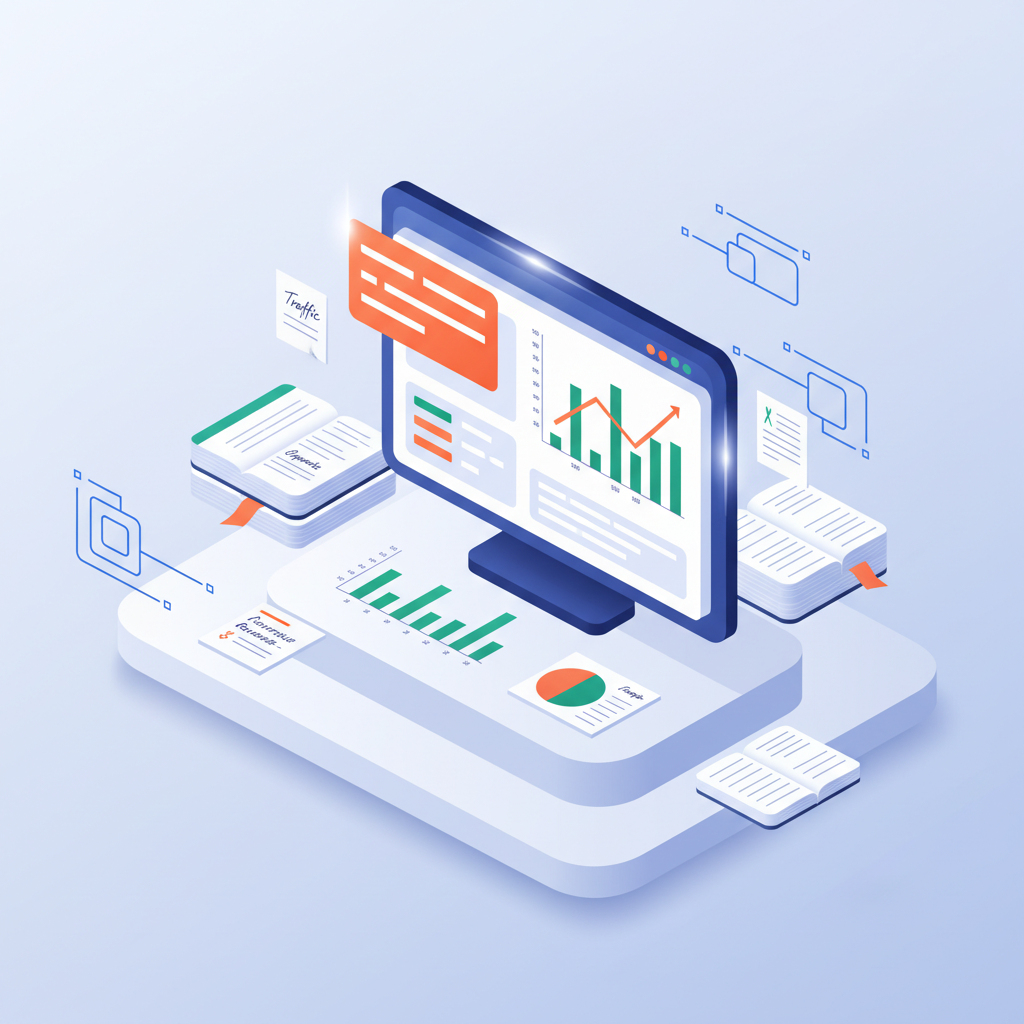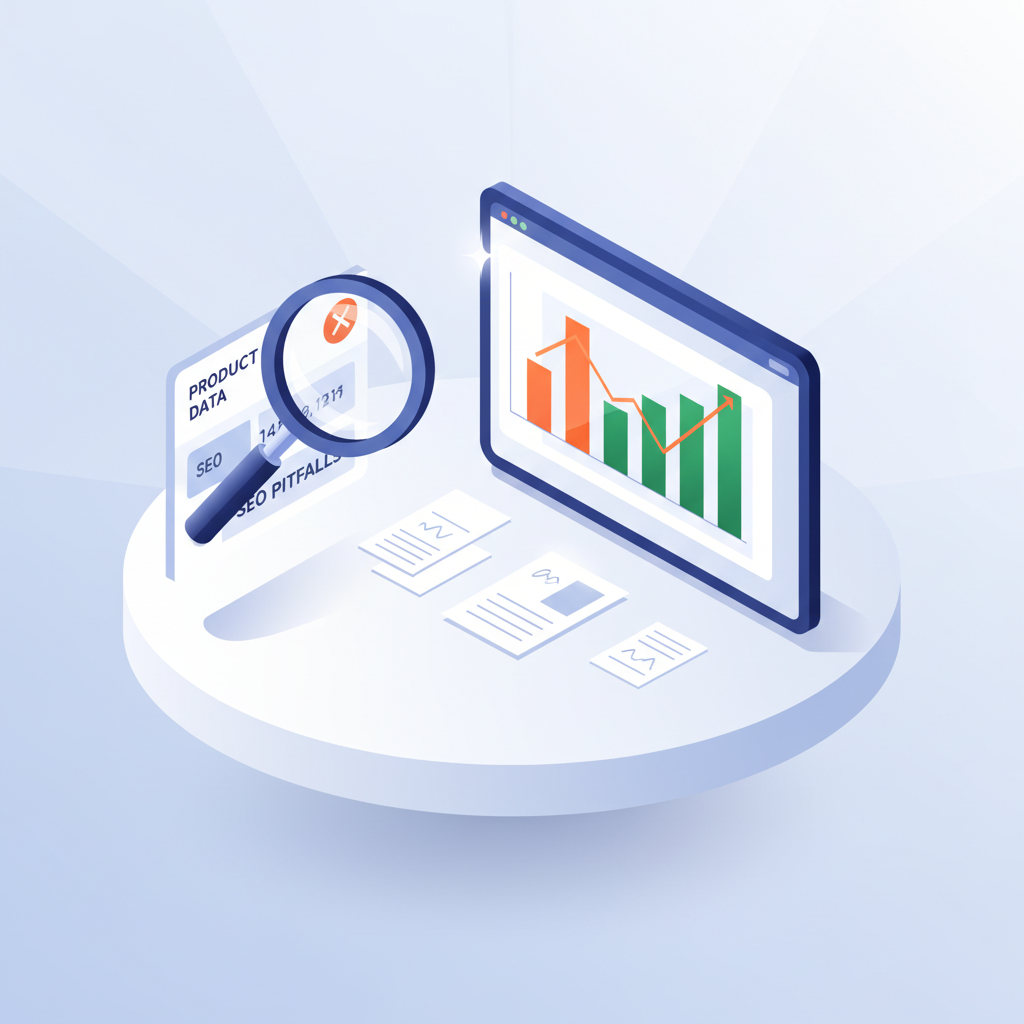Key Takeaways
- In 2025, ecommerce SEO must prioritize AI answer engine visibility to remain competitive, as traditional ranking strategies no longer guarantee buyer discovery.
- Ecommerce SEO differs significantly from traditional SEO due to large product catalogs, dynamic inventory, and conversion-focused goals requiring specialized strategies.
- The ESSO Co Framework leverages AI-driven, always-on systems across seven pillars to optimize ecommerce SEO at scale and accelerate organic traffic growth.
- Effective ecommerce keyword research targets specific buyer intents and AI assistant queries rather than generic terms, enabling faster identification of high-impact opportunities.
- Optimizing product and category pages with unique content and strategic internal linking is essential to convert SEO traffic into revenue and avoid penalties from duplicate manufacturer descriptions.
Table of Contents
- Why Ecommerce SEO Is Mission-Critical in 2025
- What Sets Ecommerce SEO Apart: Unique Challenges & Opportunities
- 7 Pillars of Agentic Ecommerce SEO (ESSO Co Framework)
- Winning Keyword Research for Ecommerce: Move Beyond Vanilla Terms
- Optimizing Product & Category Pages: Turning Traffic into Revenue
- Technical SEO: Architectures Built for Speed, Scaling, and AI Search
- Content Strategy Engineered for Google & AI Answer Engines
- Reporting, Analytics, and the 100-Day Traffic Sprint Model
- 100-Day Traffic Sprint Execution: From Audit to Acceleration
- Measuring SEO ROI: Beyond Rankings to Revenue Attribution
- Avoiding Common Ecommerce SEO Pitfalls That Kill Growth
- The Future of Ecommerce SEO: Preparing for AI-First Commerce
- Choosing the Right SEO Partner for Sustainable Growth
Why Ecommerce SEO Is Mission-Critical in 2025
In 2025, over 63% of all shopping journeys begin online, with global ecommerce sales projected to surpass $7.4 trillion. But here’s what most founders miss: ranking #1 on Google doesn’t guarantee visibility anymore. AI answer engines like ChatGPT (now processing 2.5 billion daily prompts) and Google’s AI Overviews (appearing in 13% of searches) are reshaping how buyers discover products.
The brutal reality? If your brand isn’t surfaced in AI-powered answers, you’re invisible to the modern buyer. Traditional SEO focused on driving clicks to your site. Today’s game is about being mentioned by AI assistants in ways that influence purchasing decisions, before buyers even visit your website. Book a Free AEO and SEO Strategy Call to ensure your brand is visible where it matters most.
I’ve watched 8-figure brands lose market share overnight because they optimized for yesterday’s search landscape. The brands winning now understand that seo services for ecommerce websites must evolve beyond blue links to capture the AI-driven buying journey.
What Sets Ecommerce SEO Apart: Unique Challenges & Opportunities
Ecommerce SEO isn’t just “regular SEO with products.” It’s an entirely different discipline requiring specialized strategies for catalog complexity, inventory fluctuations, and conversion-focused optimization. For more insights on ecommerce SEO fundamentals, visit our blog.
| Aspect | Traditional Business SEO | Ecommerce SEO |
|---|---|---|
| Page Volume | 10-100 pages | 1,000-100,000+ product pages |
| Primary Goal | Lead generation | Direct revenue conversion |
| Content Challenges | Static service descriptions | Dynamic inventory, duplicate manufacturer copy |
| SERP Features | Featured snippets, local pack | Shopping results, product schema, reviews |
| Technical Complexity | Basic site architecture | Faceted navigation, product feeds, schema markup |
The biggest killer? Thin content from manufacturer descriptions. I’ve seen brands with 50,000 SKUs get penalized because 80% of their product pages used identical supplier copy. Commerce Data Integration, connecting product feeds, structured data, and catalog automation, becomes your competitive moat.
7 Pillars of Agentic Ecommerce SEO (ESSO Co Framework)
Traditional SEO agencies still think in terms of monthly deliverables. We’ve built something different: always-on AI content systems that execute strategy at machine speed with human oversight. Here’s our seven-pillar framework that’s driving results for brands doing $250M+ in combined annual revenue.
1. Intent-Driven Keyword Research
We map buyer intent clusters using AI-powered analysis, targeting both traditional search and answer engine queries. Instead of generic “running shoes,” we identify “best orthotic running shoes for flat feet”, terms that convert and get cited by AI assistants.
2. Automated Content Engineering
Our agentic systems generate unique product descriptions, FAQ sections, and topical content in minutes, not months. Single keyword input → fully optimized article → published and internally linked, all while maintaining brand voice and conversion focus.
3. Technical SEO at Scale
Automated audits identify and fix technical issues across massive catalogs. Core Web Vitals optimization, schema injection, and crawl path management happen continuously, not quarterly.
4. Programmatic Internal Linking
Entity-based linking systems create logical crawl paths between related products, categories, and content. Every new page gets contextually linked within minutes of publication.
5. Answer Engine Optimization (AEO/GEO)
We optimize for AI citations, not just rankings. Structured comparisons, data tables, and direct answers designed to be surfaced by ChatGPT, Perplexity, and Google’s AI Overviews.
6. Compounding Link Acquisition & Digital PR
Systematic outreach through HARO, Reddit engagement, and commerce syndication builds authority that compounds monthly. We focus on mentions that influence both traditional search and AI training data.
7. Real-Time Analytics + 100-Day Traffic Sprint
Transparent reporting with measurable KPIs every two weeks. Our Traffic Sprint methodology identifies quick wins while building long-term compounding growth, typically 250% organic traffic increase within 90 days.
Winning Keyword Research for Ecommerce: Move Beyond Vanilla Terms
Most ecommerce brands waste months targeting obvious keywords like “buy running shoes.” The money is in understanding buyer jobs-to-be-done and the specific problems your products solve.
Our AI-assisted research process maps competitor gaps in under three minutes. We analyze what questions buyers ask AI assistants, then reverse-engineer content strategies that capture both search traffic and AI citations. For a deeper dive into keyword research strategies, check out our latest articles.
Start with seed keywords, then expand using entity relationships and attribute combinations. “Running shoes” becomes “best running shoes for overpronation” or “lightweight trail running shoes for women.” This approach uncovers high-intent, low-competition opportunities that traditional keyword tools often miss. By focusing on these nuanced queries, you position your brand to be cited by both Google and AI answer engines, driving compounding growth instead of chasing saturated terms.
Optimizing Product & Category Pages: Turning Traffic into Revenue

Your product and category pages are where SEO traffic converts to revenue, yet most ecommerce brands treat them as afterthoughts. I’ve seen 7-figure Shopify stores with manufacturer copy on every PDP and category pages that are essentially glorified product grids. That’s leaving money on the table.
Start with product page fundamentals: unique descriptions that speak to buyer intent, not just features. Instead of “Premium leather construction with reinforced stitching,” write “Built to last through daily commutes and weekend adventures, reinforced stitching prevents the heel separation that ruins cheaper dress shoes after 6 months.” This approach targets long-tail queries while addressing real buyer concerns.
Schema markup transforms your PDPs into rich snippet magnets. Product schema with price, availability, and review data gets you star ratings in search results. FAQ schema answers the “Will this fit?” and “How long does shipping take?” queries that influence purchase decisions. I deploy structured data injection that automatically applies schemas to new SKUs, no manual work required. For more on optimizing product and category pages, see our in-depth guide.
| Element | Standard Approach | Optimized Approach | Traffic Impact |
|---|---|---|---|
| Product Descriptions | Manufacturer copy | Unique, buyer-focused content | 35% higher dwell time |
| Images | Basic product shots | WebP format, descriptive alt tags, lifestyle context | 20% faster load times |
| Schema Markup | None or basic | Product, Review, FAQ schemas | 60% more rich snippets |
| Internal Linking | Random related products | Entity-based, attribute-driven connections | 25% deeper site engagement |
Category pages need strategic depth beyond product listings. Add 200-300 words of category-specific content that addresses buyer education, “How to choose running shoes for your gait type” or “Understanding thread count vs. fabric quality in bedding.” This content should live above the fold, with products below, creating topical authority while maintaining commercial intent.
Technical SEO: Architectures Built for Speed, Scaling, and AI Search
Technical SEO makes or breaks catalogue-based sites. I’ve audited ecommerce stores with 50,000+ products where Google was only indexing 12% of pages due to crawl depth issues and faceted navigation chaos. Your technical foundation determines whether AI answer engines can even find your content, let alone surface it in responses.
Crawl architecture comes first. Your homepage should reach any product page within three clicks maximum. Use breadcrumb navigation with proper schema markup, and implement intelligent internal linking that connects products through attributes, material, use case, brand, price range. This creates entity relationships that both Google and AI systems can understand and traverse.
Site speed directly impacts rankings and conversions, a 10-second load time correlates with a 35% drop in conversion rates. Deploy automated Core Web Vitals monitoring that flags issues before they impact performance. Image optimization should be systematic: WebP format, proper sizing for mobile/desktop, and lazy loading for product grids. Our agentic systems identify and resolve technical errors in under three minutes, from broken internal links to missing alt tags.
Schema markup extends beyond individual products to site-wide structured data. Organization schema establishes brand authority, while sitelinks searchbox schema enables direct product search from SERPs. FAQ schema on category pages captures long-tail queries, and comparison table schema helps AI engines surface your products in feature-based answers. This multi-layered approach ensures visibility across traditional search and emerging AI platforms. For a comprehensive overview of ecommerce SEO, see this external resource on ecommerce search engine optimization.
Content Strategy Engineered for Google & AI Answer Engines
Content isn’t just for blue links anymore. AI answer engines like ChatGPT, Perplexity, and Google’s AI Overviews are reshaping how buyers discover products. Your content strategy must serve both traditional search intent and AI prompt responses, what I call dual-channel optimization.
Answer-ready content formats perform best: comparison tables, structured lists, and FAQ sections that directly address buyer questions. Instead of generic blog posts, create “Best running shoes for flat feet: 2025 comparison” with detailed feature tables that AI can parse and quote. These structured comparisons appear in 40% more AI responses than traditional paragraph-heavy content.
Programmatic content creation scales this approach across your entire catalog. Using agentic systems, I can generate buyer’s guides, feature comparisons, and FAQ clusters for hundreds of product categories simultaneously. Each piece follows proven templates while maintaining uniqueness, no duplicate content issues, just systematic coverage of high-intent queries.
The “surround sound” approach amplifies individual products through multiple content touchpoints. A single running shoe gets featured in category guides, comparison articles, seasonal roundups, and problem-specific recommendations. This creates multiple pathways for discovery while building topical authority that benefits your entire product range. Internal linking connects these pieces intelligently, creating content ecosystems that compound over time.
Reporting, Analytics, and the 100-Day Traffic Sprint Model

Most ecommerce SEO efforts fail because they lack systematic measurement and realistic timelines. The 100-Day Traffic Sprint model breaks SEO into measurable phases with clear milestones, making it possible to track progress and adjust tactics before quarterly reviews.
Days 1-30 focus on foundation building: technical audits, keyword mapping, and content gap analysis. We identify the highest-impact opportunities, typically 20-30 primary keywords that can move the needle within 90 days. Days 31-60 shift into content production and technical implementation, where our agentic systems deploy optimized product descriptions, category pages, and supporting content at scale. The final phase, days 61-100, focuses on amplification through strategic link building, answer engine optimization, and performance refinement.
This systematic approach eliminates the guesswork that plagues most ecommerce SEO efforts. Instead of hoping for gradual improvements over 6-12 months, brands see measurable traffic increases within the first quarter, with compounding growth continuing long after the initial sprint. For more on privacy and analytics, see our privacy policy.
Sprint Success Metric: Our 7 and 8-figure brands under management, representing over $250M in combined annual revenue, typically see 150-300% organic traffic increases during their first 100-day cycle, with sustained growth continuing through subsequent quarters.
Measuring SEO ROI: Beyond Rankings to Revenue Attribution
Traditional SEO reporting focuses on vanity metrics, keyword rankings, organic traffic, and domain authority scores. For ecommerce brands, these numbers mean nothing without clear revenue attribution. Our approach centers on business metrics that directly impact your bottom line.
Revenue per organic session becomes the primary KPI, supported by conversion rate optimization and customer lifetime value tracking. We monitor which keywords drive actual purchases, not just website visits. Product-specific ranking improvements get measured against sales velocity for those exact SKUs. This data-driven approach reveals the true ROI of seo services for ecommerce websites, making it easier to justify continued investment and scale successful tactics.
Answer engine optimization adds another layer of measurement complexity. We track brand mentions in AI-powered search results, monitor citation accuracy across different AI platforms, and measure how often your products appear in comparison tables generated by ChatGPT, Perplexity, and Google’s AI Overviews. This “influence measurement” becomes increasingly critical as more buyers rely on AI assistants for purchase decisions. For additional guidance on ecommerce website security, refer to this guide from NIST.
Avoiding Common Ecommerce SEO Pitfalls That Kill Growth

The biggest mistake I see ecommerce founders make is treating SEO like a traditional brochure website. They focus on homepage rankings instead of product page optimization, or they create generic blog content that doesn’t connect to their actual inventory. This approach wastes months of effort and budget while competitors capture market share.
Technical mistakes compound these strategic errors. Duplicate content from manufacturer descriptions, poorly structured URL hierarchies, and missing schema markup create artificial ceilings on organic growth. Many brands also neglect mobile optimization for their product catalogs, losing potential customers who research and buy on mobile devices.
The most expensive mistake is treating SEO as a one-time project rather than an ongoing system. Search algorithms evolve constantly, competitors launch new products, and customer search behavior shifts with market trends. Brands that succeed with seo services for ecommerce websites build always-on optimization processes, not campaign-based initiatives.
The Future of Ecommerce SEO: Preparing for AI-First Commerce
The next wave of search disruption is already here. AI answer engines are becoming the primary research tool for high-intent buyers, fundamentally changing how customers discover and evaluate products. By 2026, I predict that answer engine optimization will be as critical as traditional Google SEO for ecommerce success.
This shift requires a complete rethinking of content strategy. Instead of optimizing for blue links, we’re optimizing for direct answers, comparison tables, and AI-generated product recommendations. Structured data becomes even more important, as does creating content specifically designed for AI consumption, detailed product specifications, clear feature comparisons, and comprehensive FAQ sections.
The brands that thrive in this new environment will be those that embrace agentic SEO systems now. Human strategy combined with AI execution speed creates a competitive advantage that traditional SEO approaches can’t match. While others debate whether AI will replace SEO, forward-thinking ecommerce brands are using AI to dominate both traditional search results and emerging answer engines.
Choosing the Right SEO Partner for Sustainable Growth
Not all SEO agencies understand ecommerce. Many apply blog-focused strategies to product catalogs, or they promise quick fixes without addressing fundamental technical issues. The right partner combines deep ecommerce expertise with cutting-edge AI capabilities and transparent reporting systems.
Look for agencies that offer revenue-share models rather than just monthly retainers. This alignment ensures your SEO partner is invested in actual business outcomes, not just deliverable completion. They should also demonstrate experience with your specific platform, whether Shopify, WooCommerce, or custom solutions, and show measurable results from similar-sized brands in your industry.
Most importantly, your SEO partner should be preparing you for the future of search, not just optimizing for today’s algorithms. Answer engine optimization, agentic content systems, and AI-powered technical audits should be standard offerings, not experimental add-ons. The agencies that understand this evolution will help you build sustainable competitive advantages, while those stuck in traditional approaches will become increasingly irrelevant.
At ESSO Co, we’ve built our entire methodology around this future-focused approach. Our agentic SEO systems, combined with deep ecommerce expertise and transparent performance tracking, have helped dozens of 7 and 8-figure brands achieve sustainable organic growth. If you’re ready to move beyond traditional SEO limitations and build a compounding traffic system that works for both Google and AI answer engines, the 100-day Traffic Sprint framework provides the proven roadmap for getting there.
Frequently Asked Questions
How does ecommerce SEO in 2025 differ from traditional SEO, and why is AI answer engine visibility so important?
Ecommerce SEO in 2025 goes beyond traditional ranking for clicks by focusing on visibility within AI-powered answer engines like ChatGPT and Google’s AI Overviews. These platforms influence buyer decisions before they even visit your site, making AI answer engine presence critical to remain discoverable and competitive in the evolving search landscape.
What specialized strategies are essential for optimizing large and dynamic ecommerce product catalogs?
Optimizing large, dynamic catalogs requires automated content personalization, frequent inventory updates, and strategic internal linking to maintain relevance and user experience. These tactics help manage scale while preventing duplicate content issues and ensuring AI systems recognize your catalog’s unique value.
How can ecommerce businesses effectively conduct keyword research to target buyer intent and AI assistant queries?
Effective ecommerce keyword research focuses on identifying specific buyer intents and the natural language prompts used by AI assistants rather than generic terms. This approach uncovers high-impact, niche opportunities that align with how modern buyers ask questions and make decisions through AI-driven search.
What are the best practices for optimizing product and category pages to convert SEO traffic into revenue while avoiding duplicate content penalties?
Best practices include creating unique, value-driven content tailored to each product and category, using strategic internal linking to guide buyers, and avoiding manufacturer descriptions verbatim. This ensures pages rank well, engage visitors, and convert traffic into sales without triggering duplicate content penalties.

